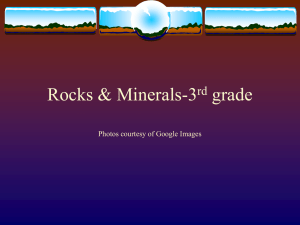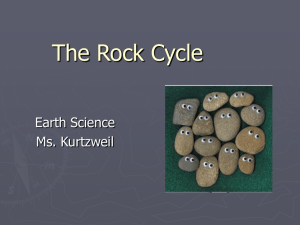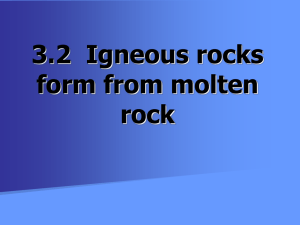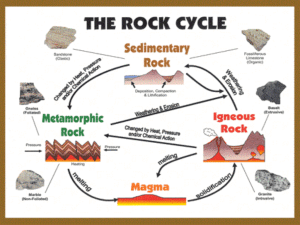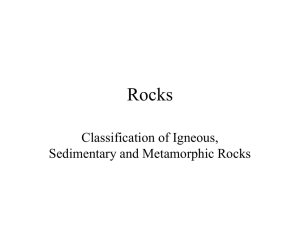Rocks
advertisement
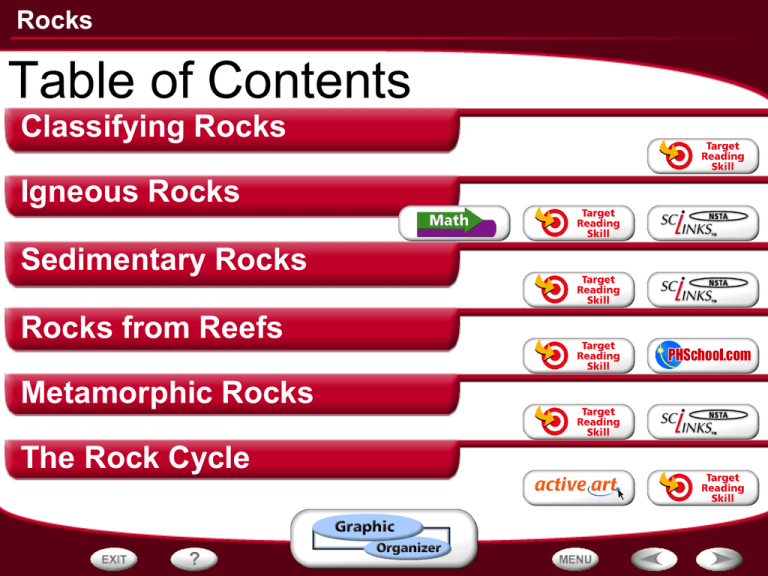
Rocks Table of Contents Classifying Rocks Igneous Rocks Sedimentary Rocks Rocks from Reefs Metamorphic Rocks The Rock Cycle Rocks - Classifying Rocks Studying Rocks • When studying a rock sample, geologists observe the rock’s mineral composition, color, and texture. Rocks - Classifying Rocks Mineral Composition and Color • Rock – a solid mixture of minerals and other materials. • Rock-forming minerals – the common minerals that make up most of the rocks of Earth’s crust. – Granite – tends to be a light-colored rock that has high silica content – Basalt – tends to be a dark-colored rock that is low in silica Rocks - Classifying Rocks Texture • Grains – particles of minerals or other rocks that give a rock its texture. • Texture – the look and feel of a rock’s surface, determined by the size, shape, and pattern of a rock’s grains. Rocks - Classifying Rocks Texture • Grain size – Coarse-grained – large easy to see grains – Fine-grained – so small they can only be seen under a microscope Rocks - Classifying Rocks Texture • Grain Shape – varies greatly from sand grains to large triangular grains • Grain Pattern – can vary also from layers to swirls to bands Rocks - Classifying Rocks How Rocks Form • Geologists classify rocks into three major groups: – igneous rock, sedimentary rock, and metamorphic rock. Rocks - Classifying Rocks How Rocks Form • Igneous rock – type of rock that forms from the melting then cooling of molten rock at or below the surface. • Sedimentary rock – type of rock that forms when particles from other rocks or the remains of plants and animals are pressed and cemented together. • Metamorphic rock – type of rock that forms from an existing rock that is changed by heat and pressure Rocks - Igneous Rocks Classifying Igneous Rocks • Igneous rocks are classified according to their origin, texture, and mineral composition. Rocks Classifying Igneous Rocks • Extrusive igneous rock – forms from lava on Earth’s surface. • Intrusive igneous rock – forms when magma hardens beneath Earth’s surface. • The faster igneous rock cools, the finer the grains – Extrusive igneous rock tends to be a finergrained rock than intrusive igneous rock Rocks - Igneous Rocks Mineral Mixture • Granite is a mixture of light-colored minerals, such as feldspar and quartz, and dark-colored minerals, including hornblende and different types of mica. But granite can vary in mineral composition. This affects its color and texture. Rocks - Igneous Rocks Mineral Mixture • Reading Graphs: – What mineral is most abundant in granite? – Feldspar Rocks - Igneous Rocks Mineral Mixture • Reading Graphs: – About what percentage of granite is made up of dark minerals? – 10% Rocks - Igneous Rocks Mineral Mixture • Calculating: – If the amount of quartz increases to 35 percent and the amount of dark-colored minerals stays the same, what percentage of the granite will be made up of feldspar? – 100% - (35% + 10%) = 55% Rocks - Igneous Rocks Mineral Mixture • Predicting: – How would the color of the granite change if it contained less feldspar and more mica and hornblende? – The overall color would be darker. Rocks - Igneous Rocks Links on Igneous Rocks • Click the SciLinks button for links on igneous rocks. Rocks - Sedimentary Rocks From Sediment to Rock • Most sedimentary rocks are formed through a series of processes: erosion, deposition, compaction, and cementation. Rocks - Sedimentary Rocks From Sediment to Rock • Sediment – small, solid pieces of material that come from rocks or organisms. – Usually forms due to erosion • Erosion – a destructive process in which water or wind loosens and carries away fragments of rock. • Deposition – process by which sediment settles out of the water or wind that is carrying it. Rocks - Sedimentary Rocks From Sediment to Rock • Compaction – process by which sediments are pressed together under their own weight. – Occurs over millions of years as layers build • Cementation – process by which dissolved minerals crystallize and glue particles of sediment together into one mass. – Takes place when sediment is in the presence of water Rocks - Sedimentary Rocks Types of Sedimentary Rock • There are three major groups of sedimentary rocks: – clastic rocks, organic rocks, and chemical rocks. • Clastic rock – sedimentary rock that forms when rock fragments are squeezed together under high pressure. – Can range in size from microscopic clay particles to large boulders – Ex: shale, sandstone, conglomerate, and breccia Rocks - Sedimentary Rocks Types of Sedimentary Rock • Organic rock – sedimentary rock that forms from remains of organisms deposited in thick layers. Peat Lignite – Ex: Coal and Limestone – Coal forms from the remains of swamp plants buried in water. – Limestone forms in the ocean, where Bituminous many living things, such as coral, clams, and oysters, have hard shells made of calcite that collect on the Anthracite ocean floor. Rocks - Sedimentary Rocks Types of Sedimentary Rock • Chemical rock – sedimentary rock that forms when minerals crystallize from a solution. (Reacts to HCl) – Ex: Limestone forms from calcite deposits dissolved in lakes, rivers, streams. Rocks - Sedimentary Rocks Uses of Sedimentary Rock • Sedimentary rock has been used for thousands of years in building structures, tools, and statues. – Ex: The White House in Washington D.C. is constructed of sandstone. Rocks - Sedimentary Rocks Links on Sedimentary Rocks • Click the SciLinks button for links on sedimentary rocks. Rocks - Rocks From Reefs Coral Reefs • Coral reef – a structure of calcite skeletons built up by coral animals in warm, shallow ocean water. – When coral animals die, their skeletons remain. More corals build on top of them, gradually forming a coral reef. – Only form in ocean water between 30°N and 30°S latitude Rocks Coral Reefs(not in notes) • Coral reef is really organic(from living things) limestone. • Deposits of organic limestone help geologists figure out what the environment was like long ago. • If they find a fossil of coral reef, they would know that location used to contain warm, shallow ocean water. Rocks - Rocks From Reefs More on Coral Landforms • Click the PHSchool.com button for an activity about coral landforms. Rocks - Metamorphic Rocks Metamorphic Rock • Metamorphic rock – forms when heat and pressure beneath Earth’s surface changes the appearance, texture, crystal structure, and mineral content of either igneous, sedimentary, or other metamorphic rock. Rocks - Metamorphic Rocks Types of Metamorphic Rocks • Geologists classify metamorphic rocks according to the arrangement of the Shale grains that make up the rocks. – Foliated rocks – metamorphic Slate rocks that have grains arranged in parallel layers or bands. Gneiss – Ex: Slate – metamorphic shale (denser and more compact than shale) Rocks - Metamorphic Rocks Types of Metamorphic Rocks • Nonfoliated rocks – metamorphic rocks that have randomly arranged metamorphic grains that do not split into layers – Ex: Quartzite – metamorphic sandstone Marble – metamorphic limestone Rocks - Metamorphic Rocks Links on Metamorphic Rocks • Click the SciLinks button for links on metamorphic rocks. Rocks - The Rock Cycle A Cycle of Many Pathways • Forces deep inside Earth and at the surface produce a slow cycle that builds, destroys, and changes the rocks in the crust. Rocks - The Rock Cycle • Rock cycle – processes on the surface and inside Earth that slowly change rocks from one kind to another. Rocks - The Rock Cycle The Rock Cycle and Plate Tectonics • Plate movements start the rock cycle by helping to form magma, the source of igneous rocks. • Plate movements also cause faulting, folding, and other motions of the crust that help to form sedimentary and metamorphic rocks. Rocks - The Rock Cycle Rock Cycle Activity • Click the Active Art button to open a browser window and access Active Art about the rock cycle. Rocks - The Rock Cycle Rock Cycle Magma Metamorphic Sedimentary Igneous Rocks Graphic Organizer Rocks can be Igneous Sedimentary Metamorphic include include include Intrusive Extrusive Clastic Organic Chemical Foliated Nonfoliated





